
What Type of Nose Do I Have? A Quick Look at Nose Shapes
If you’ve ever stood in front of a mirror wondering, “What type of nose do I have?” - this blog is for you. From the elegant shape of a Greek nose to the delicate charm of a button nose, or the bold lines of a hawk nose or Roman nose, each shape has its own story. This guide walks you through the most common and culturally diverse types of noses seen around the world, such as:
- Button nose
- Greek nose
- Nubian nose
- Snub nose
- Roman nose
- Hawk nose
- Flat nose
- Celestial nose
- Fleshy nose
- Bulbous nose
- Bumpy nose
Read on to find out what makes your nose uniquely yours, which famous people share your nose shape, and the best way to afford a rhinoplasty (nose surgery) without your finances taking a hit.
Before you start speaking, your nose has already spoken. It quietly shapes the world’s perception of you, defines first impressions, and hints at your personality traits or cultural roots. From adorable button curves to elegant Grecian slopes, nose types are more than just aesthetic quirks. They’re stories sculpted in skin and bones.
But what if your original nose doesn’t align with your vision of yourself? Maybe you admire the regal look of a Roman nose, or envy the delicate lift of a celestial one. Or perhaps, you’re dealing with a bulb or bump that doesn’t sync with the rest of your nose’s features. That’s where modern cosmetic surgeries help you, not just as a means to “fix” your nose, but to make you feel more confident while looking in the mirror.
Let’s learn about the different types of noses, how each one of them defines facial identity, and the surgical options available to those considering a change. We’ll also discuss how platforms like Denefits are making nose surgery more financially accessible.
What Are the Different Types of Noses?
Noses come in various shapes and sizes, and just like fingerprints, no two are the same. Over time, plastic surgeons, facial analysts, and anthropologists have identified some common nose types across different regions and ethnicities.
How Are Nose Types Defined?
The different types of noses are defined by their physical attributes, such as the slope of the bridge, tip angle, size of the nostrils, etc. They are also characterized based on their cultural significance and aesthetic appeal.
Understanding your nose shape can help you appreciate your unique features or guide you towards the appropriate cosmetic solution if you’re considering a nose transformation. Let’s explore the most popular nose types and what makes each one stand out.
1. The Button Nose: Small, Soft, and Universally Adored
The button nose shape is one of the most admired nose shapes. It is often associated with innocence, charm, and youthfulness. The button nose features a short nasal bridge and a soft, rounded tip resembling a button. It sits at the center of the face, proportionately, adding a playful touch to one’s features, without overpowering the lips, eyes, or jawline.
The button nose is often portrayed in the media and pop culture as an ideal nose shape, often seen on doll-like models or animated princesses. But it’s quite rare in its natural form. Many individuals have a button nose with slight variations, such as a more prominent nasal bridge or nostrils flaring outward.
Why Is the Button Nose Shape So Popular?
Rounded features, including noses, are considered more friendly, approachable, and non-threatening. From a cultural perspective, the button nose has been idealized in Western and Asian beauty standards, especially for women. The appeal lies in its balance and neatness.
Can You Get a Button-Shaped, Small Nose With Surgery?
Yes, modern rhinoplasty techniques can help refine your natural nose into a more button-like shape. This involves narrowing the nose bridge, softening the tip, and restructuring the nostrils if required. It’s important to know that a skilled surgeon prioritizes harmony over imitation.
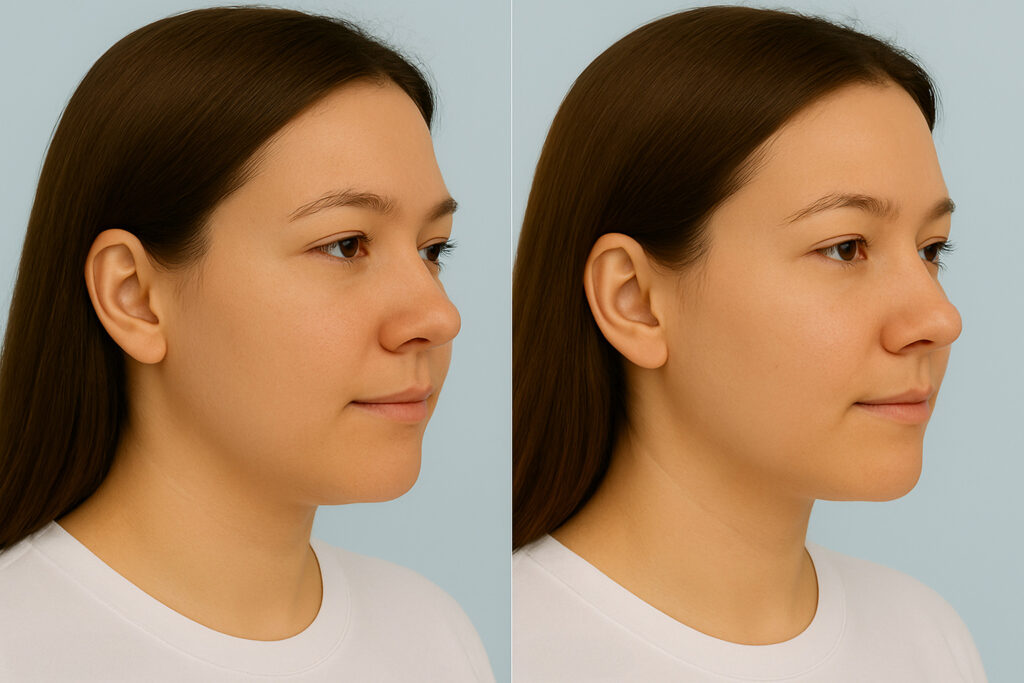
Button Nose at a Glance
| Feature | Details |
| Shape | Small, soft, rounded tip; short nasal bridge |
| Vibe | Youthful, charming, playful |
| Cultural Appeal | Idealized in Western & Asian beauty standards |
| Common in Media | Often seen on dolls, animated characters, and models |
| Surgical Option | Achievable via rhinoplasty by refining bridge, tip, and nostrils |
| Famous Examples | Scarlett Johansson, Emma Watson, Bruno Mars, Taylor Swift |
2. The Greek Nose: A Straight Symbol of Classic Beauty
The Greek nose, also known as the straight nose or Grecian nose, is desired for its clean and linear profile. Its features include a straight nasal bridge that runs from the forehead to the tip without any bumps or curvature. The sleek shape of a Greek nose creates a symmetrical and harmonious appearance, often regarded as a hallmark of classical beauty.
It’s called the “Greek nose” because it was a common sight in ancient Greek sculptures, such as statues of Gods and Goddesses like Venus or Apollo.
Why Is the Greek Nose/Grecian Nose So Admired?
The Greek nose has been adored for centuries due to its elegant, defined look. Its straightness often reflects balance, strength, and logic—qualities embraced both in art and personality. In modern times, it is usually linked with the “perfect nose” notion for its ability to blend with both sharp and soft facial features.
Roman Nose vs Greek Nose
Both Roman nose and Greek nose are strong and classical nose types. While the Greek nose has a smooth, straight bridge, the Roman nose shape has a prominent bump or curve. The Greek nose is minimalist and balanced, whereas the Roman nose is dramatic and bold.
Are Greek Noses a Common Preference in Women?
Yes! In fact, Greek nose trends have grown tremendously across social media platforms like Pinterest and Instagram. Women seeking rhinoplasty often look up to celebrities like Meghan Markle or Natalie Portman, who are considered to have variations of the Greek nose. Its elegance perfectly complements strong angular jawlines and soft, feminine facial features.
Can You Get a Greek Nose With Surgery?
Yes, with rhinoplasty, a professional can straighten and smooth your nasal bridge and refine its tip to sculpt a Greek-style nose. If you have a bumpy nose, the surgeon will reduce the dorsal humps and create a clean line from your forehead to the tip of your nose.

Greek Nose at a Glance
| Feature | Details |
| Shape | Straight nasal bridge, no bump or curve |
| Cultural Link | Inspired by ancient Greek sculptures |
| Popular Among | Both men and women, especially in Europe |
| Symbolism | Symmetry, balance, elegance |
| Surgical Option | Commonly achieved via dorsal hump removal and tip refinement |
| Famous Examples | Jennifer Aniston, Tom Cruise, Gal Gadot |
3. The Nubian Nose: Wide, Graceful, and Culturally Rich
The Nubian nose, also referred to as the African nose in some contexts, is recognized for its broad base, wide nostrils, and a long bridge gently extending downward. It’s a prominent nose shape commonly observed in people of African descent. It carries a deep historical, cultural, and aesthetic significance.
The common features of a Nubian nose include:
- A straight, long, or gently sloped bridge
- A wide nasal base
- Flaring nostrils
- A more pronounced, yet balanced tip
The Nubian nose has been underrepresented in the mainstream beauty media. It’s now being increasingly celebrated for its symmetry and elegance that exudes natural strength.
Did you know?
As per Britannica, the name “Nubian” refers to the inhabitants of ancient Nubia, a northeastern African region known for its rich history, early civilizations, and royal heritage.
The Representation and Beauty Perception of a Wide Nose With Big Nostrils
The Nubian nose has been subjected to biased beauty standards, especially in Western contexts that favored narrower noses. However, in recent years, this narrative is changing as celebrities and influencers from African and Afro-Caribbean communities are celebrating and reclaiming the distinctive beauty of their natural features.
Former president Barack Obama and singer Rihanna are said to have this nose shape. Celebrated individuals like Viola Davis, Jenelle Monáe, and Lupita Nyong’o have also proudly embraced their Nubian nose on global platforms, contributing to inclusive beauty conversations.
The Nubian Nose as an Ethnic Nose
Undoubtedly, the Nubian nose is an ethnic nose shape, exuding authenticity, grace, and cultural identity. It complements various facial features, including high cheekbones, full lips, and rich skin tones. Many people admire this nose type for its uniqueness and natural definition, now being appreciated across industries like film, fashion, and modeling.
Can You Reshape a Nubian Nose With a Nose Job?
Yes, some individuals opt for a nose job or rhinoplasty to:
- Narrow the nostrils or nasal bridge
- Raise the nasal tip
- Adjust parts of the nose for perceived symmetry
A skilled surgeon is adept at preserving the natural beauty and structural integrity of the Nubian nose, while accommodating your personal goals. You may wish to refine the nasal tip, build up the bridge, or narrow your nostrils to achieve a more balanced and refined look.
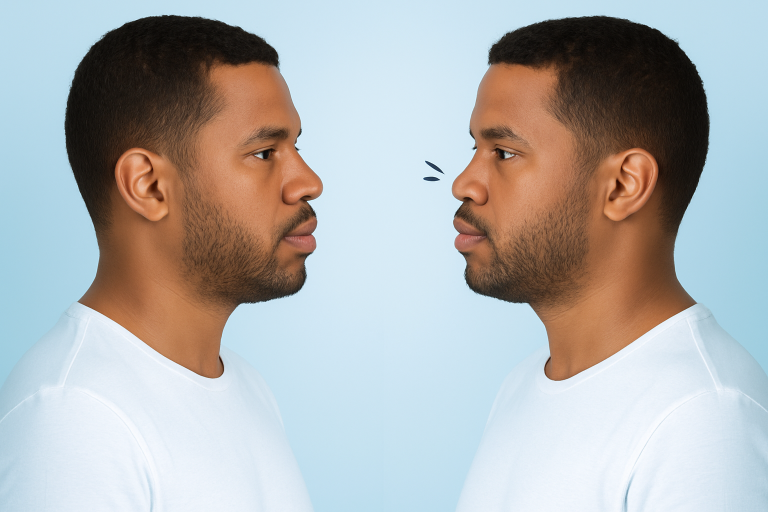
Nubian Nose at a Glance
| Feature | Description |
| Nose Shape | Long with a wide base and downward-pointing tip |
| Common Traits | Prominent nasal bridge, flared nostrils, extended length from bridge to tip |
| Cultural Background | Associated with African ethnic groups, especially from the Nubia region |
| Aesthetic Perception | Strong, regal, and statuesque; admired for its uniqueness and heritage |
| Surgical Options | Some choose subtle reshaping to narrow the nostrils or lift the tip, while preserving ethnic identity |
| Famous Examples | Barack Obama, Rihanna, Viola Davis, Janelle Monáe |
The artistry behind shaping your nose may be priceless, but the cost of a nose surgery is overwhelming for many. With Rhinoplasty costs soaring up to $18,000, you need easy and flexible payment options that make your cosmetic goals more achievable and less stressful. With Denefits’ no-credit-check payment plans, getting a nose job is easier than you would imagine!
4. The Snub Nose Shape: Small, Turned Up Nose, Full of Personality
The snub nose has a short length, a subtle upturn at the tip, and a slight concave curvature along the nasal bridge. It usually appears compact and perky, giving a youthful yet slightly mischievous look. This nose shape doesn’t project far from the face, thus making other facial features, such as the cheekbones or eyes, stand out better.
Despite being small in size, the snub nose tends to be attractive because of its playful and refined appearance. It’s sometimes also called the small nose, or the turned-up nose, depending on structural variations and regional preferences.
Why Is This Small Nose Shape So Recognized?
Snub noses are compact and aesthetically pleasing. Moreover, they reflect light in flattering ways during photoshoots, making them favorable for media, fashion, and the animation industry. It’s considered a “cute” nose shape and is associated with youthfulness and friendliness.
Can the Snub Nose Be Surgically Created?
While many people have a naturally snub nose, it’s also commonly requested in cosmetic rhinoplasty. Procedures to get a snub nose involve shortening the nose length and rotating the tip upward. It’s essential to approach a skilled surgeon to avoid dramatic results that harm your facial balance.

Snub Nose at a Glance
| Feature | Snub Nose |
| Shape | Short, slightly upturned, with a rounded tip |
| Common Traits | Compact nose, often small in size; youthful and soft appearance |
| Cultural Appeal | Frequently seen in Western media; associated with cuteness and approachability |
| Rarity | Fairly common, though exaggerated versions are less typical |
| Surgery Option | Tip refinement and rotation to reduce or enhance the upturned effect while keeping proportions balanced |
| Famous Examples | Zac Efron, Elizabeth Taylor |
5. The Roman Nose: Bold, Strong, and Timeless
The Roman nose is one of the most easily identifiable nose shapes. Also called the aquiline nose, it’s defined by a prominent bridge that may bend or curve slightly. The term “aqiline” has been derived from the Latin word “aquilinus”, meaning eagle-like. The Roman nose gives you a striking, eagle-like appearance, reflecting strength, leadership, and classic beauty.
Characteristics of the Roman Nose Shape
Individuals with a Roman nose have a strong nasal profile. Their nasal bridge arches or curves outwards, while the nose tip may point downward, giving the nose a long and firm structure. The Roman nose has been idealized since ancient times, and is prominently observed in Middle Eastern, Mediterranean, and some European cultures.
Historical Significance of the Roman Nose
Historically, Roman warriors, emperors, and philosophers were depicted with this distinctive nose type. It has been seen as a symbol of intelligence, determination, and confidence.
In multiple cultures, the Roman nose is perceived as a mark of charisma and authority. It’s not surprising that many actors, models, and public figures with this nose shape are admired for their bold looks, especially elevated by a brow ridge and well-defined jawline.
Can a Roman Nose Be Altered With Rhinoplasty?
Yes, a rhinoplasty procedure can soften the arch of a Roman nose, especially if you’re seeking a balanced facial profile. This may include dorsal hump reduction and tip elevation. Some people also opt for non-surgical rhinoplasty or filter-based reshaping to reduce the curvature subtly or achieve a straighter nose bridge.
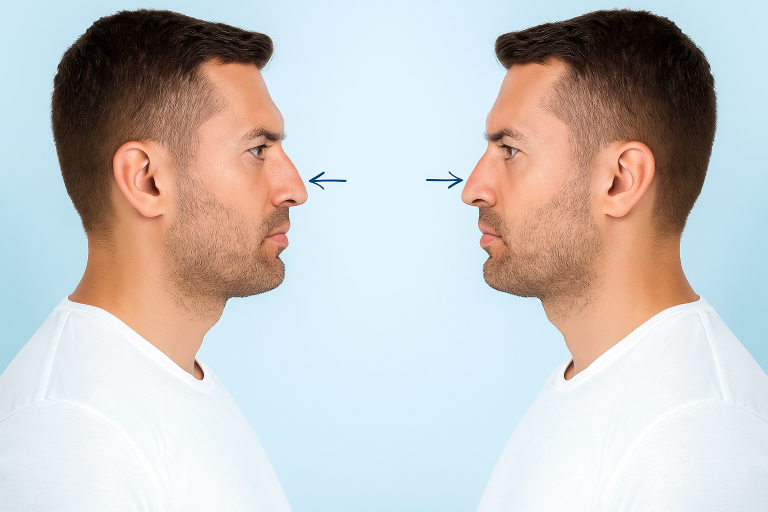
Roman Nose at a Glance
| Feature | Roman Nose |
| Shape | Prominent, with a high bridge that arches or curves downward |
| Common Traits | Strong profile, elongated shape, often slightly hooked tip |
| Cultural Appeal | Associated with leadership, intellect, and classical beauty |
| Rarity | Common in Mediterranean and Middle Eastern ethnicities |
| Surgery Option | Dorsal hump reduction, tip refinement, or non-surgical filler reshaping |
| Famous Examples | Meryl Streep, Daniel Radcliffe, Ryan Gosling, Gisele Bündchen |
Does Insurance Cover Rhinoplasty?
Insurance coverage for Rhinoplasty depends on your specific insurance plan and medical reason for the procedure. If you’re seeking a nose job to correct a functional issue and improve your overall quality of life, your insurance may cover it. Even if it does, you may incur out-of-pocket costs, such as deductibles or copays.
However, if you simply wish to improve your nose’s appearance, cosmetic rhinoplasty isn’t typically covered by insurance. In such scenarios, it’s wise to choose cosmetic surgery payment plans that offer payment flexibility. With Denefits, you can make a swift rhinoplasty decision without undergoing any credit checks.
6. The Hawk Nose: Striking, Defined, and Unmistakable
The Hawk nose, sometimes called the beak nose or eagle nose, has a dramatic shape and downward curve, resembling the hook of a bird’s beak. The hawk nose gives your face an intense, serious expression because of its bold and highly defined features. It can be quite captivating and commands presence.
Defining Features of a Hawk Nose
The hawk nose type is characterized by features like:
- A prominent nasal bridge curving downward
- A hooked or pointed tip
- An elongated, narrow structure
- Angular, sharp contours
This shape stands out in profile more than from the front. The distinct features are associated with independence, strength, and strong character. It’s commonly spotted among the people of Mediterranean, Middle Eastern, and Eastern European origins.
Cultural and Social Perception
The mainstream media may promote smoother, daintier nose shapes such as the celestial or button nose, but the hawk nose has its admirers, especially in art and high fashion. Many historical sculptures and portraits signify the hawk nose as a symbol of nobility and wisdom.
Can a Hawk Nose Be Reshaped With Surgery?
Yes, you can seek rhinoplasty to reduce the prominence of the hawk nose, using the following measures in your surgery:
- Straightening the nasal bridge
- Refining the nose tip
- Reducing the nasal hump
Some patients may choose to get only subtle adjustments to their hawk nose, retaining the original shape and improving facial symmetry.

Hawk Nose at a Glance
| Feature | Hawk Nose |
| Shape | Curved or hooked bridge with pointed tip; resembles a bird’s beak |
| Common Traits | Sharp profile, narrow bridge, downward slope |
| Cultural Appeal | Historically linked to strength, wisdom, and artistic character |
| Rarity | Common among Mediterranean and Middle Eastern ethnicities |
| Surgery Option | Hump reduction, bridge straightening, or tip refinement |
| Famous Examples | Adrien Brody, Barbra Streisand, Lady Gaga, Tilda Swinton |
7. The Flat Nose: A Low-Bridge Nose Shape With Strong Ethnic Roots
One of the most recognizable nose shapes, the flat nose is defined by a broad nasal base, low nasal bridge, and wide nostrils. This nose shape doesn’t have the sharp projection observed in pointy or Roman noses. The nose tip may be subtle or rounded, and the nostrils flare outward. From the side profile, a flat nose appears almost flush with the rest of the nose.
Cultural and Ethnic Background
The flat nose is commonly seen in people from East Asia, South Asia, the Pacific Islands, and Africa. Since the old beauty standards idealised high nose bridges and narrow nose shapes, people with flat noses may want to seek surgical enhancements.
Rhinoplasty or Surgery Options
The flat nose gives you a non-dominant and smooth face profile, which suits rounded face shapes and softer jawlines. Some people may want to make cosmetic changes and opt for rhinoplasty to augment their flat noses. This procedure may include:
- Tip refinement for more definition and better projection
- Narrowing the nostrils
- Silicon implants to elevate the nasal bridge
- Cartilage grafting (using the patient’s rib cartilage or ear)
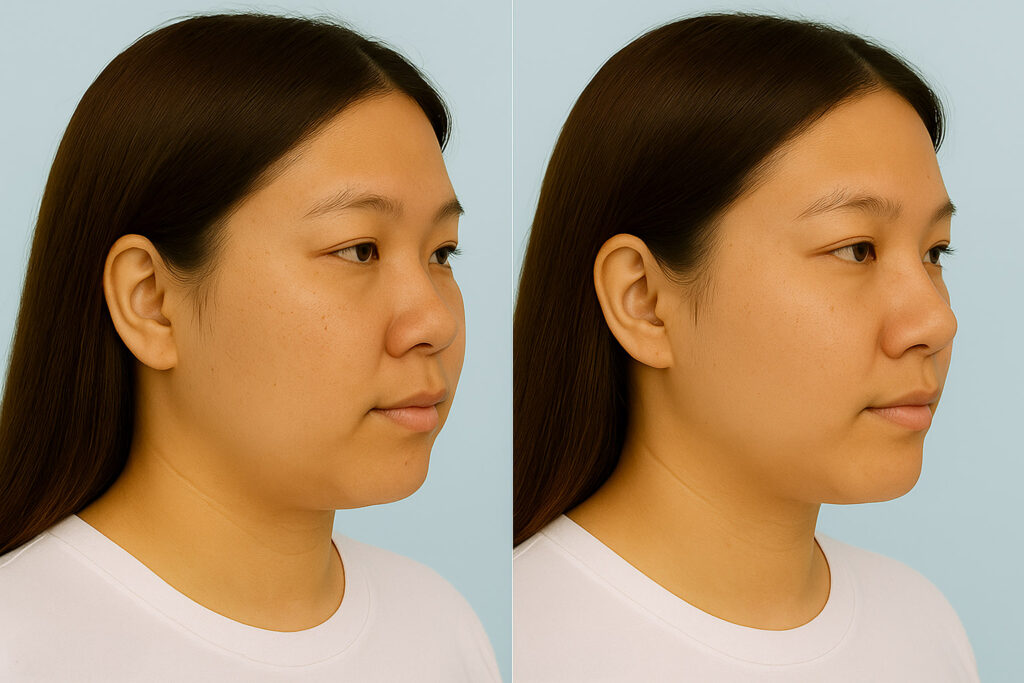
Flat Nose at a Glance
| Feature | Description |
| Nose Shape | Low nasal bridge, wide nostrils, soft or rounded tip |
| Ethnic Prevalence | East Asian, Southeast Asian, African |
| Cultural Perception | Historically stigmatized; now embraced as a cultural marker |
| Popular Requests | Bridge augmentation, nostril reshaping, tip projection |
| Surgery Options | Cartilage grafts, silicone implants, nostril narrowing |
| Famous Examples | Bruno Mars, Michelle Yeoh, Awkwafina |
8. The Celestial Nose: Balanced, Refined, and Feminine
The Celestial nose, another small and turned-up nose type, is known for its smooth bridge and upturned tip. The upward tip gives the nose an almost ethereal experience, hence the name “Celestial.”
It’s a subtle variation of the button nose, but the turned-up tip makes it look slightly more elongated and narrow. The Celestial nose is considered one of the most photogenic and ‘ideal’ nose shapes in the Western beauty standards, especially for women.
Why Is the Celestial Nose Thought To Be One of the Perfect Nose Shapes?
The Celestial nose gives your face a youthful, soft, and approachable look. It’s highly desired in cosmetic circles for its elegance and enhancing capabilities for facial features, such as high cheekbones, almond-shaped eyes, and fuller lips.
This nose type is usually seen on celebrities, influencers, and models, reinforcing its presence as one of the “perfect” noses in fashion and media.
Did you know?
In digital beauty filters and AR makeup apps, the celestial or turned-up nose is often part of the "ideal beauty preset" because of its universally flattering structure.
Can You Achieve a Celestial Nose With Surgery?
Yes, it’s possible to reshape an existing nose into a more celestial one through refined rhinoplasty. A skilled surgeon ensures that the nose complements the rest of the facial anatomy rather than standing out awkwardly. Nose surgery to get a celestial nose profile may include:
- Straightening and refining the nasal bridge
- Shortening the nose length if needed
- Elevating the nasal tip subtly
- Ensuring symmetry to avoid an artificial look
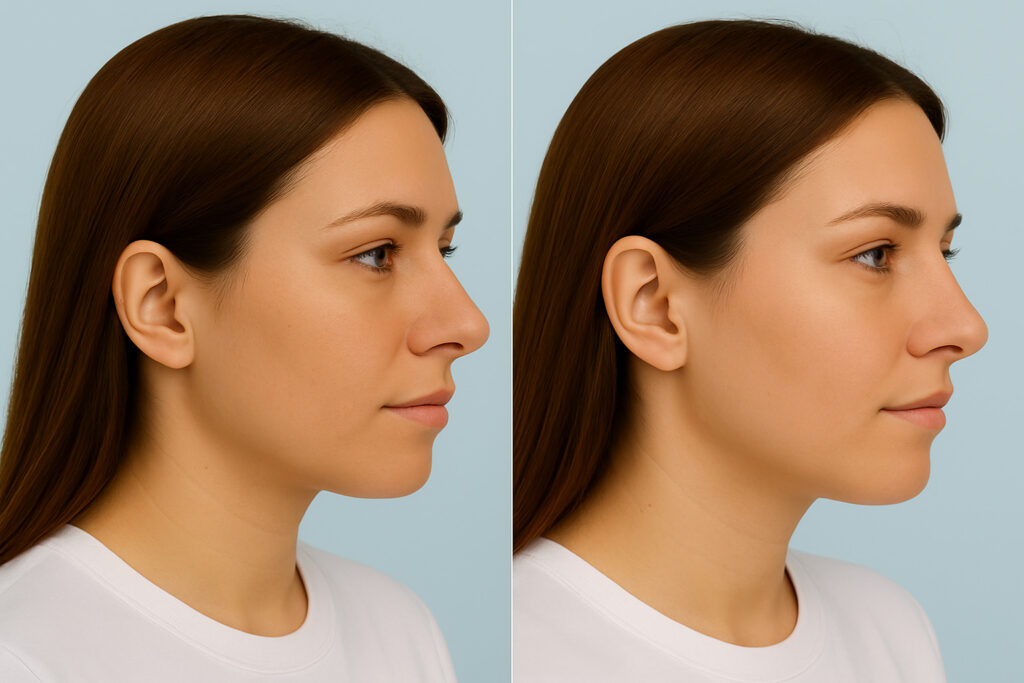
Celestial Nose at a Glance
| Feature | Description |
| Nose Shape | Small nose with straight or gently sloping bridge and an upturned tip |
| Also Known As | Turned-up nose, small nose, "perfect nose" |
| Ethnic Prevalence | Most common in Caucasian and Northern European populations |
| Cultural Perception | Seen as elegant, youthful, feminine |
| Popular Requests | Subtle tip elevation, bridge refinement, shortening |
| Surgery Options | Tip rotation via cartilage adjustment, dorsal smoothing, nostril reshaping |
| Famous Examples | Emma Watson, Natalie Portman, Lily Collins |
9. The Fleshy Nose: The Most Common Answer to “What Type of Nose Do I Have?"
The fleshy nose is among the most common and easily identified nose types across various ethnicities. It has a soft tissue, rounded appearance, and thick skin, unlike the angular and sharply contoured nose types like the Greek nose or hawk nose. It has a plumper structure due to its soft cartilage and abundance of subcutaneous tissue. The fleshy nose is more common in individuals with thicker and oilier skin textures.
Bulbous Nose: A Subtype of the Fleshy Nose
The bulbous nose is a specific subtype of fleshy nose that has a more rounded, pronounced nasal tip. As the name suggests, it has a bulb-like or ball-like appearance, resulting from thick alar cartilages and overactive sebaceous glands.
It is easy to confuse a bulbous nose with a general “big” nose, but the difference lies in the tip shape.
Did you know?
A bulbous nose isn’t always due to the fat. It may be due to cartilage configuration or hormonal activity affecting your sebaceous glands.
Is Surgery Right for a Fleshy or Bulbous Nose?
Many people with fleshy or bulbous noses can benefit from tip refinement surgeries, especially if they want a more defined profile. However, due to thick skin, the changes may be more subtle in comparison to thin-skinned noses.
Modern surgical techniques such as open-structure rhinoplasty, combined with skin redraping or cartilage grafting, allow surgeons to make visible improvements without affecting facial harmony. In such cases, recovery may take a bit longer due to swelling, especially in the nose tip.
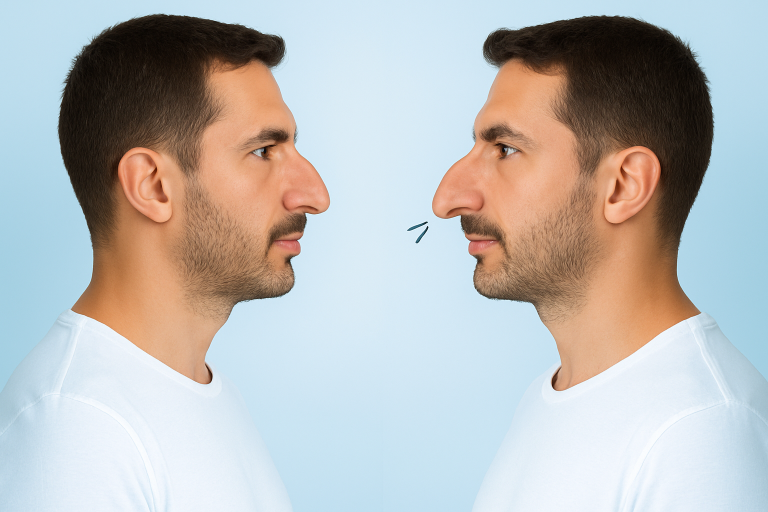
Fleshy Nose at a Glance
| Feature | Description |
| Skin Texture | Thick, often with visible pores; may appear shiny or oily |
| Structure | Soft cartilage; lacks rigid definition |
| Shape | Rounded, plump tip with a broader nose base |
| Common Concerns | Lack of nasal tip definition, wide appearance in photographs |
| Surgery Options | Cartilage grafting, tip refinement, thick-skin techniques for better definition |
| Famous Examples | Jonah Hill, Rebel Wilson (pre-rhinoplasty), Anthony Quinn |
If you’ve been wanting to enhance your facial features by changing your regular nose into a distinct type with Rhinoplasty, but the high upfront costs have been a cause of concern, choose a flexible payment plan offered by Denefits. You get to select a plan that fits your unique budget, and make monthly payments while receiving timely reminders.
10. The Bumpy Nose: Character‑Rich Contour for the Dorsal‑Hump Profile
A bumpy nose, also called the dorsal-hump nose, is characterized by a noticeable “hump” or rise along the nasal bridge. It may look straight from the front, but it has a gentle S-curve or defined ridge in profile. The bumpy nose gives your face a memorable, strong silhouette and is common in the Middle Eastern, Mediterranean, and Eastern European lineages.
Why Do Some Noses Develop a Bump?
Some noses may develop a hump because of the following reasons:
- Genetics: Most dorsal humps are inherited from past generations.
- Development: The nasal bone and cartilage may grow at different rates during the adolescent phase, leaving a bump once growth pauses.
- Trauma: A traumatic injury may heal unevenly, causing a bump even years after the incident.
Cultural Perception and Popularity
You may think straight noses to be ideal, but many cultures perceive a mild bump as aristocratic and refined (think of iconic profiles like Barbra Streisand or Gisele Bündchen).
How Can Nose Surgery Improve a Bumpy Nose?
A nose job, or rhinoplasty, can be performed to smoothen the dorsal hump by reshaping the bone and cartilage along the bridge. This renders a more balanced, straighter side profile for your face. Depending on your goals, your surgeon will either remove the bump completely or reduce it subtly, preserving the natural features.

Bumpy Nose at a Glance
| Feature | Description |
| Skin Texture | Varies; may appear normal or slightly uneven depending on bump severity |
| Structure | Noticeable hump along the nasal bridge, caused by excess bone or cartilage |
| Shape | Irregular nasal contour with a visible dorsal bump; may curve or dip slightly |
| Common Concerns | Dislike of profile appearance, asymmetry, lack of smooth bridge |
| Surgery Options | Reduction rhinoplasty, dorsal hump removal, cartilage/bone reshaping |
| Famous Examples | Barbra Streisand, Owen Wilson, Ryan Gosling (mild bump) |
Let’s Chart Nose Types Together – Which One Looks Like Yours?
Now that we’ve explored the various nose shapes, use this chart to identify yours.
| Nose Type | Defining Features | Common Concerns |
| Button Nose | Small, rounded tip, slightly upturned, soft and compact shape | May appear overly petite or less defined on certain face shapes |
| Greek Nose | Straight nasal bridge, smooth and symmetrical profile | Can seem too sharp or lack character from certain angles |
| Nubian Nose | Wider base, longer bridge, prominent nostrils | Often lacks tip definition, appears broader in photos |
| Snub Nose | Short bridge, slightly upturned tip, small and delicate appearance | May be perceived as too short or "cute" for mature faces |
| Roman Nose | Prominent bridge with slight outward curve, strong and defined | Can appear too dominant from the side view |
| Hawk Nose | Thin, sharp bridge with a dramatic downward curve | Often viewed as harsh or severe in profile photos |
| Flat Nose | Low nasal bridge, wide base, often seen in certain ethnic groups | Minimal projection, less contour in side profile |
| Celestial Nose | Smaller nose with a deeply upturned tip and visible nostrils | Nostrils may be too exposed; risk of over-rotation post-surgery |
| Fleshy Nose | Thick skin, broad tip, soft cartilage, rounded shape | Lacks definition; often appears bulbous or wide |
| Bulbous Nose | Enlarged, rounded tip, soft cartilage, sometimes part of fleshy nose type | Tip may dominate facial balance or appear swollen |
| Bumpy Nose | Uneven bridge with visible bumps, humps, or dips | Breaks nasal symmetry; affects side profile aesthetics |
How Denefits Makes Nose Surgery Affordable & Transparent for All Types of Noses
It’s overwhelming to know that getting your favourite nose with a rhinoplasty can cost approximately $12,000 to $18,000. This includes the surgeon’s fees, operating room fees, and anesthesia fees.
Typical Rhinoplasty Cost Breakdown
As per The Williams Center, a specialized plastic surgery practice, here’s an estimated cost range of each component of a rhinoplasty procedure:
| Cost Component | Estimated Range |
| Surgeon’s Fee | $9,200 – $12,500 |
| Operating Room Charges | $1,550 – $1,750 |
| Anesthesia Fees | $1,250 – $1,450 |
It’s important to find an experienced surgeon who can deliver natural results and transparent prices. The overall cost of your nose job will depend upon your surgeon’s experience, the location of the facility, and the history of your surgeries (if any).
How Denefits Supports You
Denefits enables individuals like you to embrace the type of nose that makes you feel more like yourself. Here’s why you should consider Denefits:
- With no credit checks and 95% approval rates, you’re sure to qualify.
- You can choose from a flexible payment plan that fits your needs.
- There’s no interest if you decide to pay off the entire amount early.
- Monthly payments help you improve your credit score.
Whether you have a flat, bumpy, bulbous, hawk nose, or a rare hybrid type, a proper nose surgery plan can offer harmony and elevate your natural beauty.
Final Thoughts: Different Nose Shapes Tell a Unique Story
From button aesthetics to bumpy nose bridges, every nose shape carries a distinct charm, structure, and heritage. Whether you’re simply wondering about your facial features or thinking of getting a nose job for medical or aesthetic reasons, it’s important to understand your nose type to make informed decisions. Remember, there’s no such thing as a “perfect” nose; the best nose is the one that makes you feel beautiful. If you ever choose surgical refinement, modern techniques and flexible financing options like Denefits make it more accessible than ever.
Frequently Asked Questions About Types of Nose Shapes
1. What Is a Button Nose
A button nose is a small, round-shaped nose with a slight curve at the tip. It’s often considered youthful for its delicate appearance.
2. What Is Considered a Long Nose?
A long nose typically has an extended nasal bridge. It appears larger than the average face. It may add character to the face, but some people may want to balance their nose length for a better look.
3. What Defines a Straight Nose?
A straight nose is characterized by a smooth, linear bridge without bumps or curves. It’s often symmetrical and is a common goal for people seeking rhinoplasty.
4. Can Nose Surgery Fix a Pointy Nose?
Yes, rhinoplasty can be done to soften the tip of a pointy nose. Such a nose shape has a sharp, defined tip that projects outward or downward.
5. What Is a Black Nose in Cosmetic Terms?
The term “black nose” is not a medical classification. It may refer to noses seen in people of a certain descent. One should approach this term with cultural sensitivity and avoid any generalizations.
6. What Are the Features of a Female Greek Nose?
A Greek nose in females commonly has a straight, narrow bridge and balanced structure. It’s desired for an elegant and classical appearance.
7. Are There Specific Nose Types for Females?
Certain nose types may be more common in females, including celestial, button, snub, Roman, etc.
8. What Is a European Nose?
European noses commonly feature higher nasal bridges and narrower profiles. The shapes, however, may vary by region.
9. What Are Different Nose Bridge Types?
Various kinds of nose bridge types include low, high, straight, curved, and bumpy nasal bridges. Recognizing your nasal bridge type can help you determine suitable cosmetic options.
10. What Does a Sharp Nose Look Like?
A sharp nose has well-defined angles, a narrow bridge, and a pointed tip. It gives your face a chiseled and striking appearance.




